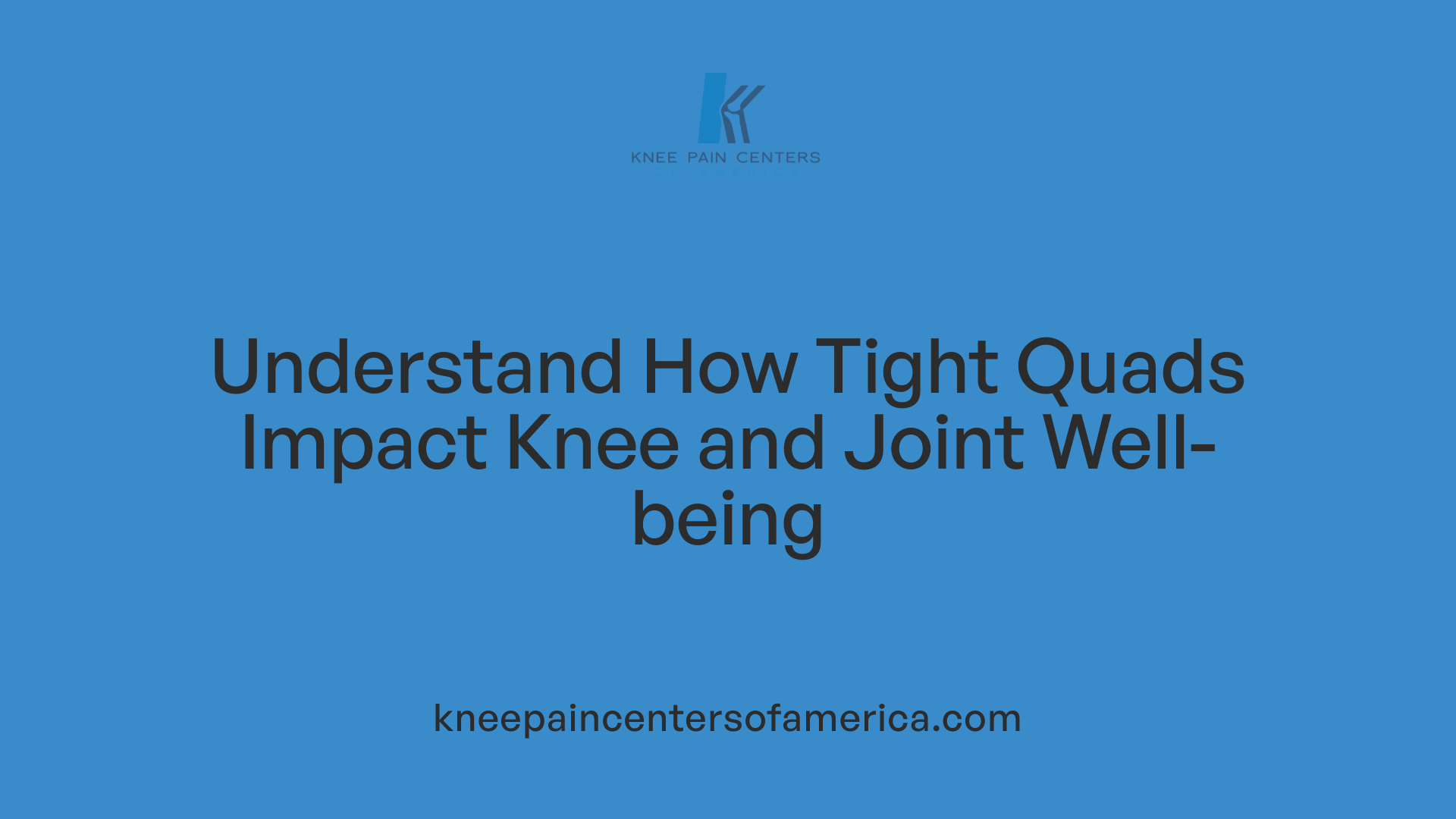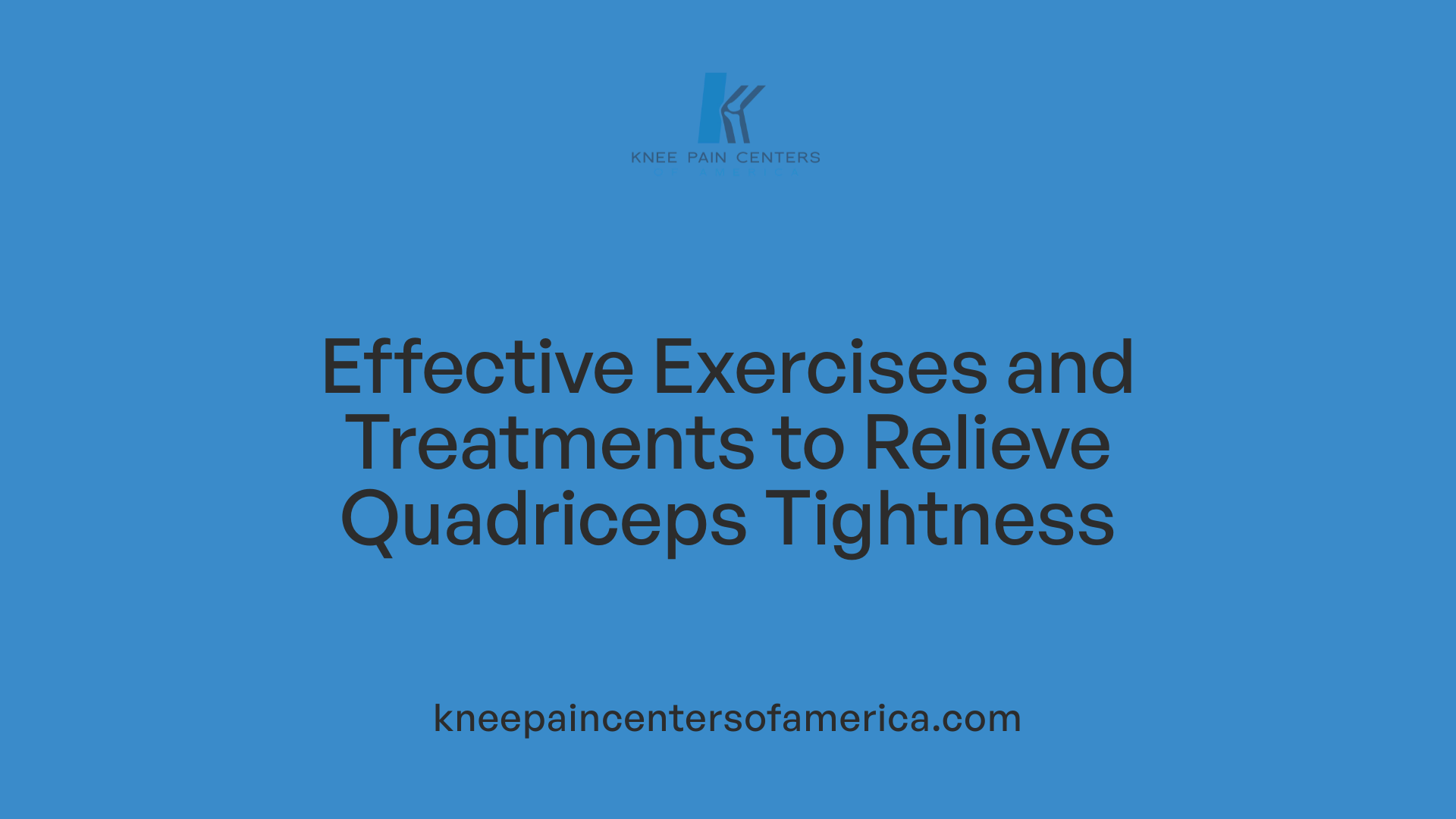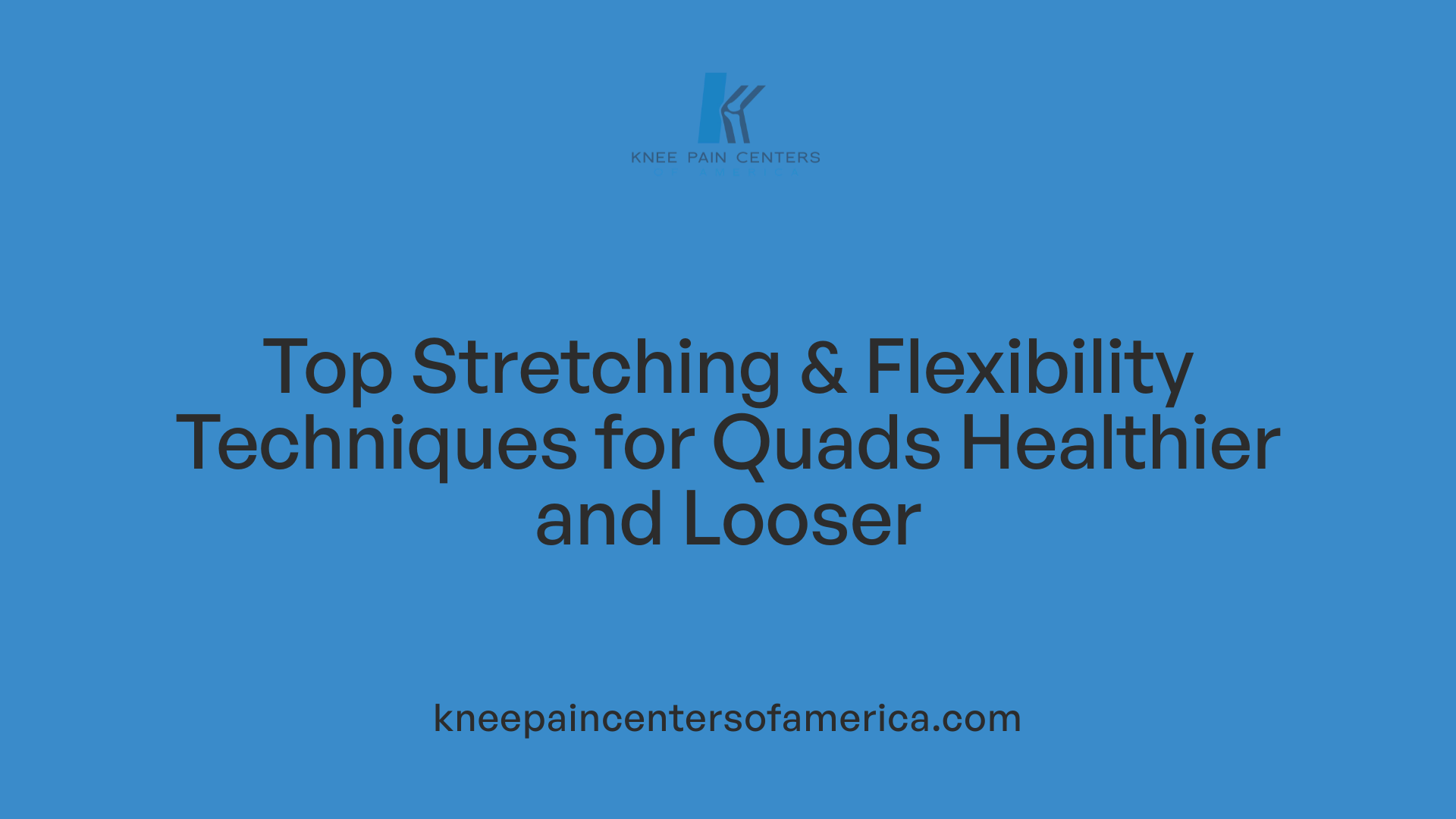What Causes Quadriceps Tightness and Its Symptoms?
Quadriceps tightness is a common issue, especially among individuals who sit for long periods or engage in repetitive physical activities. Recognizing the signs and understanding the causes are essential steps toward effective treatment and prevention.
Anatomy and Function of the Quadriceps Muscles
 The quadriceps femoris is a large and important muscle group located at the front of the thigh. It is mainly responsible for extending the knee, which is vital for movements such as walking, running, jumping, and standing upright.
The quadriceps femoris is a large and important muscle group located at the front of the thigh. It is mainly responsible for extending the knee, which is vital for movements such as walking, running, jumping, and standing upright.
Traditionally, the quadriceps are described as consisting of four main muscles: the rectus femoris, vastus lateralis, vastus medialis, and vastus intermedius. Recently, a fifth muscle called the tensor of the vastus intermedius has also been recognized as part of this group.
Each muscle has a specific role. The rectus femoris not only helps extend the knee but also crosses the hip joint, aiding in hip flexion—lifting the thigh forward. The other three muscles—vastus lateralis, vastus medialis, and vastus intermedius—primarily focus on knee extension and help stabilize the kneecap.
All five muscles converge into the quadriceps tendon, which attaches to the kneecap (patella). From there, the patellar ligament continues down to connect to the tibia, facilitating leg movement.
Innervated by the femoral nerve and supplied by the femoral artery, the quadriceps are the largest and most powerful muscle group in the body. Their strength and functionality are critical for maintaining posture, supporting body weight, and enabling complex lower limb movements.
Understanding the anatomy and role of these muscles underscores why keeping them healthy and flexible through stretching and strengthening exercises is essential, especially to prevent tightness and injuries.
Causes and Symptoms of Quadriceps Tightness

What are the common causes and symptoms of quadriceps tightness?
Quadriceps tightness is frequently caused by factors such as prolonged sitting, muscle overuse, and repetitive activities like running, cycling, or jumping. When these muscles are overworked or remain in a shortened position for too long, they can become stiff and less flexible. Inadequate stretching after exercise, lack of warm-up before activity, and inactivity can further contribute to this condition. Injuries, dehydration, and muscular imbalances between the quadriceps and other thigh muscles also play a significant role.
The symptoms related to tight quadriceps are quite noticeable. Individuals often experience muscle stiffness and soreness in the front of the thighs. They may find it difficult to bend or straighten the knee without pain, and sometimes, tightness in the hip flexors and front thigh can cause discomfort that radiates to the lower back. Other signs include reduced flexibility in the hip and knee joints, tension or pain around the thigh area, and possible tenderness when pressing on the muscles. Over time, if not addressed, muscle tightness can lead to strains, tendonitis, or joint imbalances, which may cause further discomfort or injury.
Managing tight quadriceps involves consistent stretching, warming-up routines, and modifying activity levels. Physical therapy and exercises aimed at strengthening and lengthening these muscles can also be beneficial in preventing persistent tightness and related injuries.
| Causes |
Symptoms |
Additional Details |
| Prolonged sitting |
Front thigh pain |
Maintaining proper posture and regular movement |
| Overuse from exercise |
Difficulty knee flexion |
Incorporating proper stretching routines |
| Repetitive activities |
Lower back pain |
Correcting muscular imbalances |
| Lack of stretching/warm-up |
Reduced hip and knee flexibility |
Staying hydrated and avoiding overexertion |
| Injury |
Tenderness, swelling |
Seeking medical advice if pain persists |
| Dehydration |
Muscle weakness |
Using foam rolling and targeted stretches |
| Muscular imbalance |
Reduced range of motion |
Avoiding prolonged static postures |
Effects of Tight Quadriceps on Knee and Joint Health

How does tightness in the quadriceps affect knee health and joint function?
Tight quadriceps muscles can have a significant impact on the health and functionality of the knee joint. When these muscles are overly tight, they tend to pull the kneecap (patella) out of proper alignment, which can cause discomfort, pain, and even abnormal wear of the cartilage over time.
This misalignment disrupts normal movement patterns and places extra stress on the knee joint, especially during activities like walking, running, or jumping. As a result, the joint may experience increased impact forces and decreased shock absorption, potentially accelerating degenerative processes such as osteoarthritis.
Research indicates that passive stiffness in the quadriceps—mainly in muscles like the rectus femoris and vastus medialis obliquus (VMO)—is associated with a higher risk of developing knee osteoarthritis. This stiffness reduces the joint’s range of motion, impairing movement efficiency and increasing strain on surrounding tissues.
Furthermore, limited flexibility in the quadriceps can hinder proper joint function, affect overall biomechanics, and contribute to muscle imbalances. To maintain knee health and prevent adverse effects, regular stretching and strengthening exercises targeting the quadriceps are essential. These practices help preserve mobility, reduce pain, and support the long-term integrity of the knee joint.
Effective Treatment and Exercise Strategies for Relieving Quad Tightness

What are effective treatment options and exercises for relieving quadriceps tightness?
A comprehensive approach to address tight quadriceps combines stretching, manual therapy, and strengthening routines. Regular stretching exercises are fundamental; scene examples include standing quad stretches, kneeling lunges, and yoga poses like the hero pose or crescent pose. These stretches help lengthen the muscles and alleviate tension, restoring more natural movement.
In addition to static stretching, engaging in targeted exercises such as isometric holds—like wall sits and seated knee extensions—can improve both flexibility and muscle strength. Progressive resistance activities, including controlled squats and step-down exercises, aid in balancing muscle tension and preventing future tightness.
Manual techniques also play a vital role. Massage therapy, foam rolling, and joint mobilization can reduce muscle stiffness, improve blood circulation, and speed up recovery. Foam rolling the quadriceps helps release muscle knots and increase tissue elasticity.
Prevention and management are enhanced by warming up before physical activity, avoiding static postures for prolonged periods, and gradually increasing exercise intensity. Combining these various approaches results in increased flexibility, diminished discomfort, and overall better mobility.
Maintaining a consistent stretching routine, employing manual therapy when necessary, and including strengthening exercises collectively help keep the quadriceps healthy and functional. This multi-pronged strategy not only relieves existing tightness but also minimizes the risk of recurrence.
Stretching and Flexibility Techniques to Reduce Quadriceps Tightness

What stretching and flexibility techniques can help reduce quadriceps tightness?
To release tight quadriceps muscles and improve flexibility, there are several effective stretching and flexibility techniques. Incorporating these methods into your routine can also help prevent injuries and reduce pain in related areas like the knees, hips, and lower back.
Static stretches are especially beneficial after physical activity. These stretches involve holding a muscle in a stretched position for a period, typically 20-30 seconds. Common static stretches for the quads include:
- Standing quadriceps stretch: Bend one knee, grasp your ankle, and gently pull the heel toward your glutes while keeping your knees close together.
- Lying side quad stretch: Lie on your side and pull your heel toward your buttocks, ensuring hips stay level.
- Kneeling quad stretch: In a kneeling position, push your hips forward and pull your back foot toward your glutes.
- Prone (lying face down) quad stretch: Lie on your stomach and pull your foot toward your glutes.
Dynamic stretches prepare your muscles for activity and help prevent tightness when done before exercise. Movements include leg swings or walking lunges that gently stretch the quads.
Foam rolling is a form of self-myofascial release that can help loosen tight muscles, break down scar tissue, and improve overall tissue flexibility. Rolling the front of your thighs for about 30-60 seconds can alleviate tension and enhance mobility.
Regularly practicing these stretching techniques, combined with foam rolling, supports muscle health, prevents soreness, and keeps your lower body more flexible. Remember to perform stretches gently and consistently for the best results.
Role of Yoga and Physical Therapy in Managing Quadriceps Tightness
How can yoga and physical therapy help alleviate quadriceps tightness?
Yoga and physical therapy offer effective approaches to manage and reduce tightness in the quadriceps muscles. By focusing on targeted stretches and postures, these methods improve muscle elasticity and increase the range of motion, which helps relieve discomfort and prevent injury.
Certain yoga poses are particularly beneficial. For example, the Low Lunge, Hero Pose, and Dancer’s Pose actively stretch and strengthen the quadriceps, promoting muscle lengthening and flexibility. These poses also contribute to better joint stability and balance, reducing the risk of developing issues such as knee and lower back pain.
Physical therapy typically combines manual techniques, such as massage and foam rolling, with specific stretching exercises like static holds and proprioceptive neuromuscular facilitation (PNF) stretching. These approaches help increase stretch tolerance and improve joint flexibility over time.
Regularly practicing these exercises can address muscle imbalances caused by prolonged sitting, inactivity, or overuse. Enhanced flexibility and muscle health not only alleviate existing tightness but also support overall mobility, making daily movements more comfortable. Additionally, strengthening exercises can balance muscle activity around the hips and thighs, further reducing strain.
In summary, integrating yoga postures and physical therapy routines helps release tight quadriceps, reduces associated pain, and promotes long-term muscle health. These practices support recovery, enhance performance, and foster better posture and movement efficiency, contributing to overall wellness.
Understanding Trigger Points and Muscle Pain in Quadriceps
What are trigger points and how do they relate to muscle pain in the quadriceps?
Trigger points are small, hyperirritable knots or tight bands that form within muscles, including the quadriceps. These spots often develop from muscle overuse, injury, poor posture, or imbalances. When pressed, trigger points can cause localized tenderness, but they can also refer pain to other regions, such as the front of the thigh or even down to the knee.
In the quadriceps group—which includes muscles like the rectus femoris, vastus lateralis, and vastus medialis—trigger points can lead to symptoms like deep knee pain, stiffness, or a feeling of weakness. They can also restrict movement, making activities like bending the knee or walking uncomfortable.
The development of trigger points is often linked to repetitive stress from activities such as running, cycling, or prolonged sitting, especially if muscles are not adequately stretched or strengthened. If left untreated, these knots can cause persistent discomfort and may contribute to muscle imbalances or joint problems.
Releasing trigger points can significantly improve muscle function and reduce pain. Techniques such as manual massage, foam rolling, stretching, or targeted pressure can deactivate these knots. Regular self-care routines, including stretching the quadriceps and incorporating foam rolling, are effective preventive measures.
Addressing trigger points is essential not just for immediate pain relief but also for maintaining healthy muscle function and avoiding chronic issues. Proper management helps restore mobility, supports injury prevention, and enhances overall lower body wellness.
For more detailed information, searching "trigger points in quadriceps muscles" can provide additional insights and strategies for treatment.
Related Conditions and Considerations in Quadriceps Management
Are there related conditions or considerations to be aware of when dealing with quadriceps tightness?
When addressing tightness in the quadriceps muscles, it's important to consider other underlying or associated conditions that may be contributing to the problem. Muscle imbalances, for example, where one muscle group is stronger or tighter than its opposing muscles, can lead to abnormal stress on the quadriceps and surrounding joints.
Additionally, tendinopathies such as quadriceps tendinitis or tendinosis can cause pain and stiffness, especially for active individuals or athletes. Joint issues, including arthritis in the knee or hip, may also present with similar symptoms and influence muscle health.
Systemic musculoskeletal disorders like osteoarthritis, inflammatory arthropathies, or systemic conditions such as fibromyalgia and hormonal imbalances can contribute to muscle tightness and discomfort. Nerve-related diseases affecting muscle control, such as peripheral neuropathies or nerve entrapments, can lead to weakness or abnormal muscle tone, complicating treatment.
Muscle disorders, including myopathies like muscular dystrophy or inflammatory muscle diseases such as myositis, may cause or worsen muscle tightness, weakness, and pain. Repetitive overuse injuries from activities like running, cycling, and prolonged sitting can also exacerbate quadriceps tightness.
It is essential to recognize these potential related conditions to ensure a correct diagnosis and develop an effective treatment plan. Addressing systemic issues, correcting muscle imbalances, and managing underlying joint or nerve problems can significantly improve outcomes. Consulting healthcare professionals for a comprehensive assessment is recommended when symptoms persist or worsen over time.
Maintaining Healthy Quadriceps for Optimal Movement
Quadriceps tightness is a multifaceted condition that can significantly impair mobility, cause discomfort, and contribute to other musculoskeletal issues if left unaddressed. Understanding the anatomy and function of these muscles helps in recognizing the causes—be it overuse, inactivity, or injury—and implementing effective stretching, strengthening, and manual therapies. Regular practice of targeted exercises, yoga, and flexibility routines can alleviate tightness, improve joint health, and prevent further complications. Proper care, including addressing trigger points and related conditions, is crucial for comprehensive muscle health. For individuals experiencing persistent symptoms, consulting healthcare providers or physical therapists is recommended to develop personalized strategies. Overall, proactive management and consistent maintenance are key to keeping quadriceps healthy and supporting overall mobility and quality of life.
References